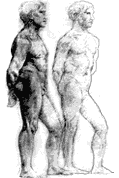Part Four in a Six-Part Series

by Alicia Potter
Traditionally considered female afflictions, eating disorders are affecting body-conscious men, as well. It's well documented that for women, body obsession can lead to extreme dieting and exercise. How widespread are eating disorders among men? Hard to say. Men are notoriously hesitant to seek psychological treatment, particularly for body-image disorders. Some sources report an increase in these problems among men, but T. Donald Branum, a Newton, Massachusetts, psychotherapist specializing in eating disorders, points out that the rise could simply be a matter of awareness: as clinical sensitivity to male eating disorders increases, therapists are diagnosing the problem with more frequency. What we do know is that of the eight million Americans being treated for eating disorders, one million are men. According to Branum, men make up about 10 percent of anorexics and about 20 percent of bulimics. Nearly half of binge eaters are men. Branum, who treats men aged 15 to 65, reports that many men are ashamed to suffer from a "woman's illness." Indeed, the term "eating disorder" usually conjures the image of a white, suburban teenage girl. But eating disorders among men were documented in medical journals as far back as 1649. It's even suspected that Franz Kafka suffered from anorexia; hence his short story "The Hunger Artist." Recently, researchers at Massachusetts General Hospital found that gay men face a special risk for eating disorders, particularly bulimia. Like women, gay men feel undue pressure to adhere to a lean look. "There's a high level of expectation in my culture," says Boston Body manager Brian Borrelli, who is gay. "A gay guy's supposed to have neat clothes, a fit body, a certain sophisticated style. It's easy to take that to the extreme." Which he did. In high school Borrelli weighed 225 pounds. When he came out in college, he began dieting to fit the gay community's beauty ideal. He skipped breakfast, grabbed a salad for lunch, and ate soup for dinner. He also ran eight miles a day. In seven months, Borrelli was down to 135 pounds. No one recognized that he was anorexic. "There was never any help offered to me," he says. "Let's face it, you're not going to be waiting for the T one day and look up and find a sign that says, 'Are you a white gay man suffering from anorexia?'" For the most part, eating disorder research has ignored male sufferers. And many treatment facilities exclude men, although body-image problems appear to have the same causes in both men and women. Branum reports that his patients with eating disorders typically grapple with issues of control, anger, and sexuality; food becomes their coping mechanism. Although Branum doubts a man can develop an eating disorder simply from spending too much time reading GQ, he does believe that a man with an eating disorder may look to media images to determine physical goals. He explains, "The man begins to think, 'If I look like that guy in the magazine, then things will be okay inside me.'" This article originally appeared in The Boston Phoenix. Part Five: Silicone for Everyone — Male Eating Disorders |








